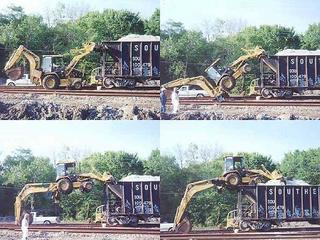OH&S
I get the B3TA newsletter every week. Sometimes I think that's a good thing and sometimes I delete it without reading it because of the "We're terribly witty because we send up the mainstream" style of writing they employ. Last week I read it and I'm glad I did.
 Backhoes are God's gift to the middle aged man-child. I love backhoes. L-U-V love'em. This series of photos from a link in the newsletter goes a long way towards explaining why. If I met the bloke driving the backhoe I'd buy him a beverage of his choice. Two of them, maybe. That's a pretty darned impressive piece of backhoe-ery. I can put one up into the back of a tipper, but this guy is way outta my league.
Backhoes are God's gift to the middle aged man-child. I love backhoes. L-U-V love'em. This series of photos from a link in the newsletter goes a long way towards explaining why. If I met the bloke driving the backhoe I'd buy him a beverage of his choice. Two of them, maybe. That's a pretty darned impressive piece of backhoe-ery. I can put one up into the back of a tipper, but this guy is way outta my league.
 Backhoes are God's gift to the middle aged man-child. I love backhoes. L-U-V love'em. This series of photos from a link in the newsletter goes a long way towards explaining why. If I met the bloke driving the backhoe I'd buy him a beverage of his choice. Two of them, maybe. That's a pretty darned impressive piece of backhoe-ery. I can put one up into the back of a tipper, but this guy is way outta my league.
Backhoes are God's gift to the middle aged man-child. I love backhoes. L-U-V love'em. This series of photos from a link in the newsletter goes a long way towards explaining why. If I met the bloke driving the backhoe I'd buy him a beverage of his choice. Two of them, maybe. That's a pretty darned impressive piece of backhoe-ery. I can put one up into the back of a tipper, but this guy is way outta my league.Allow me to pass on a couple of mildly amusing anecdotes regarding backhoes. Actually, they're not all that amusing, but they do serve to make me look like a wild-eyed rebel flying in the face of conformity. Or..., not.
WARNING: Gratuitous self-aggrandisement follows!
I first learned to drive a backhoe on a Case 590 SuperL . It's still my all-time bestest backhoe. The farm I was on at the time used PTB (pipe through bank) irrigation instead of syphons. This meant that the head ditches were a little higher, between a metre and about 1.3 metres, it also meant that the banks of the head-ditches were wider, wide enough to drive along. As well as that, the headlands were wider; because you couldn't swing the implement out over the channel bank as you were turning around, plus the rotobucks (temporary earth mounds put up to control the direction the water flows) were 24 metres apart instead of two.
These last two factors, plus the nature of flow from PTB's meant that it was often necessary to get down into the headland area with the backhoe and do some running repairs during irrigation. Plenty of mud for everybody. Once the repairs had been carried out and it was time to leave the fun started. There were 28 fields on that farm; it was possible to reverse up onto the head-ditch in two of them. The preferred method on the rest was to reverse up as far as you could - not far, usually. Then unfold the hoe, reach out and stick the bucket into the opposite side of the bank you wanted to climb, push the boom down to lift the rear of the 'hoe off the ground, then fold it up again, which had the effect (if you got it right) of pulling the machine up the bank.
Sometimes the hydraulics just didn't have enough grunt in them, so then you would lift the front bucket up, fold it under like you were emptying it, stick it into the ground, then fold it back upright. This, coupled with the aforementioned method usually got you out of trouble. If it didn't, then the fun really started. The official Carlos Fandango Approved method then was to employ both techniques at once - with the machine at full revs and reverse gear engaged.
Think about it for a minute - you're supposed to face forward when driving or operating the loader bucket, but rearwards when operating the hoe. It's usually some ungodly hour in the morning at the end of a week or two of nightshift, you're blasé because this is all you've been doing for the last week, you're trying to pull yourself up a muddy four or five foot high bank and stop on the six foot wide bit on the top because there's a channel full of water on the other side, you're operating a loader bucket and a backhoe at the same time - and the wheels are spinning just as fast as you can make them go.
Strangely enough, sometimes it goes wrong. I saw a bloke (the one who taught me to drive the beast) pull himself up one side of the head-ditch and straight down the other, into about four feet of water. We left the engine running (it had a low-level exhaust and we didn't want water to suck back down into the engine - also it keeps the crankcase pressurised) and went for a tractor and chain. I backed the tractor up tp the opposite side of the head-ditch and hooked the chain up. The other bloke operated the backhoe, trying to drag himself across. It didn't work - the chain just cut through the channel bank without the backhoe moving, but it did look amusing, with nothing of the 'hoe visible except for the boom, cab and airfilter, being operated by an unfit man in his undies who was bracketed by two huge rooster tails of muddy water coming off the (otherwise submerged) rear tyres. We had to get a crane from town to lift it out eventually. No lasting damage, though - changed all the oils, drained the fuel tank, changed all the filters and she was away.




3 Comments:
What a fun article to read! You really know what you're doing with construction equipment (about which I happened to help write a simple website).
ok, that's impressive...
Holy Moly. Is that 3rd picture real, and 4th picture?
Well your techniques are pretty impressive as well.
Here's my backhoe site FWIW
Post a Comment
<< Home